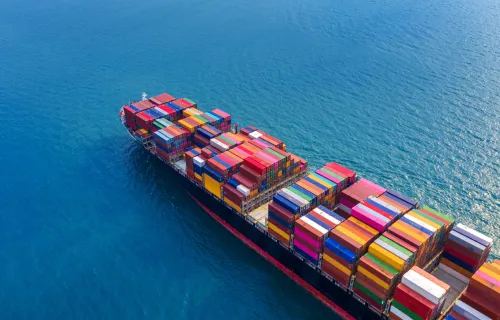La série de balados What’s Happening in Trade de CGI présente les actualités et les perspectives les plus récentes dans le milieu du financement commercial et des transactions bancaires. Dans le cadre de ce balado, le expert en commerce Patrick DeVilbiss invite des dirigeants d’entreprises des domaines du financement commercial et des services bancaires à nous faire part de leur point de vue sur la situation actuelle et future du secteur.
Dans la première partie de cette série de balados, Patrick s’entretiennent avec Sudhir Dole, chef de la direction du Trade Information Network (en anglais seulement), pour en apprendre davantage sur les derniers développements du réseau. Fondé par six grandes banques mondiales en 2019, le Trade Information Network est un réseau qui permet l’échange de données commerciales en temps réel entre les acheteurs, les fournisseurs et les banques du monde entier, grâce auquel les institutions financières peuvent mieux évaluer les risques liés au financement. Il facilite également la collaboration entre les banques et les aide à déceler de nouvelles possibilités de revenus.
Selon Sudhir, le réseau joue également un rôle important pour pallier le déficit de financement commercial actuel de 1,5 billion de dollars américains. Il explique pourquoi cet écart est difficile à combler, en mentionnant entre autres les risques liés au financement commercial ouvert, comme la fraude, et comment la plateforme du réseau minimise ces risques en fournissant davantage de données et en misant sur des données de meilleure qualité. Par exemple, lorsqu’un fournisseur cherche à obtenir du financement auprès d’une banque et présente un bon de commande, la banque est en mesure de le valider en accédant aux données par l’entremise du réseau à partir de la source d’origine, soit l’acheteur.
Comme l’indique Sudhir, la plateforme du réseau est capable d’héberger un volume élevé de données commerciales en temps réel (p. ex. données sur les bons de commande, les factures, les expéditions, les notes de crédit, le financement, etc.) et permet également de les vérifier et de les analyser afin d’en assurer la grande qualité. De plus, la plateforme améliore considérablement le flux des données. Bien que sa structure de données soit normalisée, elle offre également de la flexibilité en permettant aux participants de partager différents éléments de données, selon leurs besoins et leurs propres systèmes de gestion intégrés. Les données peuvent aussi être facilement téléversées dans la plateforme et partagées par les participants.
Alors que le nombre de réseaux auxquels les banques peuvent se joindre se multiplie, Sudhir explique en quoi le Trade Information Network se démarque des autres. L’intégration, par exemple, est simple et rapide et nécessite moins de 72 heures. Comptant de nombreux participants, le réseau offre également un accès facile à une vaste gamme de données provenant de fournisseurs variés, ainsi qu’une fonction de piste de vérification complète.
« Je vois de grandes entreprises exiger de leurs banquiers qu’ils fournissent une solution complète pour répondre aux besoins en fonds de roulement de leur chaîne d’approvisionnement, affirme Sudhir. Les entreprises veulent s’assurer que leurs chaînes d’approvisionnement sont stables et bien financées. Pour demeurer concurrentielles, les banques doivent offrir les meilleures solutions pour générer des capitaux et, si elles ne sont pas en mesure de fournir elles-mêmes la solution la mieux adaptée, elles peuvent collaborer avec d’autres banques du réseau. L’amélioration de la connaissance des clients aux fins d’intégration est une autre tendance importante. »
Pour d’autres observations de Sudhir sur le Trade Information Network et ses plus récents développements, cliquez sur le lien ci-dessous pour écouter le balado dans son intégralité. Si vous avez des questions ou des commentaires, communiquez avec Patrick ou Nancy.
- Chapter 1: Introductions
-
Patrick DeVilbiss:
Hello, everyone, and welcome to the first episode of CGI's What's Happening podcast series, featuring news and insights in the world of trade finance and transaction banking. I am Patrick DeVilbiss, offering manager for CGI's trade and supply chain finance business, and I'm joined as always by Nancy Amert, who's the director of our Trade Innovation Lab. Today, we're going to be catching up with Sudhir Dole, who's the CEO of the Trade Information Network, and learning about some of the latest developments in their emerging network. The Trade Information Network was actually created by six of the largest global banks, including ANZ, Citi, BNP Paribas, Standard Chartered, HSBC, and Deutsche Bank.
Sudhir, it's great to have you with us today, and thanks for taking part in the What's Happening podcast. We really appreciate it. Now, you and I have a bit of background between us, and our paths have crossed a few times, in particular, on the Trade Information Network. And, you're pretty well known within the global banking space and trade finance sector, as well as amongst our Trade360 community. But, I wanted to give you a minute to tell us a little bit about yourself.
Sudhir Dole:
Thank you, Patrick. Thank you, Nancy, and thank you CGI for giving me the opportunity to speak today on this podcast. I have been at the Trade Information Network for 15 months now. Before that, I was a banker for 27 years. I've worked across geographies—India, Hong Kong, and the UK—and I've spent time across various institutions, starting with the ANZ in 1992, and then Standard Chartered, and then with ICICI Bank. So, great to be here and look forward to this conversation.
- Chapter 2: What is the Trade Information Network?
-
Patrick DeVilbiss:
Fantastic. So, let's get started. What is the Trade Information Network? Can you explain a little bit for the audience that we have here, and where are you at in the journey? We know that there have been a lot of fintechs that have networks that are out there in the market. What's happening in the world of the Trade Information Network? What differentiates you a little bit?
Sudhir Dole:
Thanks, Patrick. Let me clarify what we are all about. We are an information registry, very simply put, where buyers and sellers can exchange great data with each other, and then with their bankers in turn for financing. We were founded, like you said, by the six global banks, but to serve the financial community and their clients. So, it's not restricted to these six banks, but for the entire financial community. And, by creating these six big banks, by creating this huge industry-wide platform, we make it easier for banks to finance the suppliers through the entire working capital cycle, starting from the pre-shipment stage.
We believe that we can play a very big role in bridging the trade finance gap of $1.5 trillion. Given that our founding members are such large trade banks, we are very optimistic that we'll be able to scale up quickly, and early joiners will enjoy a competitive advantage. So, please ask your customers to join us soon.
- Chapter 3: What can be done about the trade finance gap?
-
Nancy Amert:
Great. Thank you very much, Sudhir. Very interesting and great to see that kind of adoption that the Trade Information Network is seeing. I'd like to dive into one area. You spoke about something very interesting—the trade finance gap. The trade finance gap seems really stuck at this stubborn $1.5 trillion U.S. And, there's a lot of literature, a lot of research, around this, and there's some very admirable initiatives from the banks. And, with my work, in particular within the Trade Lab, we're looking at seeing if there's government support for the SMEs during the COVID-19 crisis, and also they may not want to take the risk without a government guarantee. So, what could really be done about this? What are your thoughts around this?
Sudhir Dole:
That's a great question. And, you mentioned a very, very important word in your question—risk. The reason why the trade finance gap has been so hard to bridge is because of the risk associated with open account trade. There is the risk associated with fraudulent purchase orders and invoices, there is the double financing risk, and finally, limited visibility of the transaction flow between buyers and suppliers, resulting in an inability of the bank to assist the performance risk of the supplier. Now, these risks have become even more in the limelight in recent years with a number of fraud cases that have been there, for example, in the Asian markets.
Our platform aims to address these risks by providing more data and better quality data, which can enable banks to manage these risks. Let me give you a simple example. Let's say today a supplier approaches a banker and provides them with a purchase order and seeks financing. Now the banker is not sure whether the purchase order is genuine. In our platform, the data will be provided to the banker from the original source, that is the buyer, and ideally, directly from their ERP system. So, this substantially reduces the fraud risk. Similarly, when the invoice data is submitted by the supplier, it can be authenticated by the buyer, giving comfort to the buyer.
Double financing risk is another important risk. Once a purchase order or invoice is financed on our platform, it cannot be financed again by another bank on the platform. Any bank can check the financing status of a purchase order or invoice even though they may not be associated with the transaction. As the platform becomes an industry standard, the double financing risk will be further reduced. Finally, a lot of data can be hosted on the platform. This can be analyzed by the banker to manage performance risk. So, given that Trade Information Network helps the banks to manage these risks better, we firmly believe that the flow of credit to the suppliers will improve, thus helping us to build a more sustainable supply chain.
- Chapter 4: What kind of data is on the Trade Information Network (TIN), and how can banks use this data?
-
Sharmila Banerjee:
Hey Patrick, this is Sharmila. Would you mind if I asked a question a little off the cuff, please?
Patrick DeVilbiss:
Sure, Sharmila.
Sharmila Banerjee:
Sure. You, Sudhir or anybody. So, a little new to this whole thing. So, this Trade Finance Network, it's for profit, right? And, if so, what's your source of income? I'm looking at the website; it's not easy to figure that out. Are the banks that are part of your network paying for the service, or would I as a consumer pay for the service when I ask for the loan?
Sudhir Dole:
Our platform has been created by the banks for the banking or the financial community, the larger financial community and their customers. We charge the financiers who come onto our platform an annual fee. We do not charge a fee per transaction, and we do not take a margin on their financing transactions as financing is outside the platform. We do not charge the corporates who are the buyers and suppliers of the banks or the financiers who come on the platform. So that's our income structure.
Sharmila Banerjee:
Got it. Got it. So, if I go tell my bank PNC that, "Hey, this is good, why don't you join?" They would be interested in knowing what's the overhead for them, right?
Sudhir Dole:
Absolutely. Absolutely, yeah.
Sharmila Banerjee:
Okay. And, I could reach out to somebody within CGI to figure that out?
Sudhir Dole:
Absolutely. And, from our perspective, what we are very sensitive to is the fact that banks are of different sizes and scale. So, the broadest shoulders should bear the heaviest burden to an economist. So, we keep the fees higher for larger institutions and smaller for smaller institutions.
Patrick DeVilbiss:
And, I think, Sudhir, what you touched on there was that the network itself is very focused on the flow of data, and data has become much more important in today's world. So, can you expand a little bit on what kind of data is available within the Trade Information Network and how banks are able to use that data?
Sudhir Dole:
Sure. So, like you said, we have the capacity to host a lot of data. The data structures that we support include purchase order data, invoices, shipment data, credit notes, and finally, the financing status. For example, what is the expected shipment date and what's the actual shipment date can both be stored on the platform. The banker can then analyze this data to see if the supplier is performing, and the buyer can raise credit notes on the platform. So, the banker can analyze this data to again look at dilution risk. One of the biggest challenges to finance an SME supplier is the quality of financial statements and the delay in receiving them.
By mining the data on our platform, the bank can build real-time early warning signals, which can indicate if the performance of the supplier is deteriorating. And, finally, of course, just to add one last point, is that we appreciate that all banks may not have the requisite tools to analyze this data, and so we are also looking at working with data analytics companies or rating agencies to facilitate this analysis.
Patrick DeVilbiss:
And, I think that's great. And, where you touched there, you've got a lot of endpoints, a lot of end users of that data. And, I think one of the questions, we can see data come out in a lot of formats, we can see it, there can be a lot of efforts needed to cleanse, sanitize, and repurpose data. Is there a standard format for the Trade Information Network?
Sudhir Dole:
The data structure itself is standardized, but we have a very flexible solution, which does recognize that every company may want to share different data elements. So, we have kept very few mandatory fields assuming ERPs could have different implementations and giving the flexibility to the corporate of the bank on what data comes to the platform. The corporate can upload the data; what they feel is needed or appropriate. And, this would typically be based on what they've agreed to provide to their financiers. Also, just to add, there are multiple ways in which corporates and banks can upload the data; through their web interface or uploading an Excel file, or integrating with us through APIs.
As I mentioned earlier, financing is outside the platform, so banks are free to decide on how they want to use the data. They can give a pre-shipment loan, a post-shipment loan, receivables, payables, factoring, reverse factoring. We have by design focused on being an information registry and giving complete freedom to the banks on how they want to use the data.
- Chapter 5: What’s different about the Trade Information Network’s platform?
-
Nancy Amert:
Sudhir, that's really interesting, but I'm also wondering: How challenging is it going to be for the corporates to be onboarded onto your platform? I know in my experience, too, that corporates are tired of just joining so many platforms. So. how would they be convinced that this is not just, if you will, just one more platform?
Sudhir Dole:
To answer your first question, onboarding is very straightforward. We have a limited set of questions we ask the corporate, say five or six, and then within 72 hours, we have done our KYC. and they're onboarded. It's also a simple one-time registration. On your second question, we are addressing this issue of corporates having to join multiple platforms. So, as an example, we have a corporate who's running multiple supply chain programs across several bankers or even fintechs. So, currently, they will need to be a user across each of these platforms. So, think of us that we are now providing a multi-bank platform where the corporate hosts his data on our platform, all his data, and then the corporate decides which purchase orders or invoice it's shared with which bank or fintech.
These banks or fintechs will all be users on our platform. And, as I mentioned, the corporate has multiple ways to interact with us, web interface, SFTP, or APIs, making it very convenient for them to manage their data.
Nancy Amert:
So, is there a track of who shared the data with whom? Is there some type of full audit trail functionality built into the Trade Information Network?
Sudhir Dole:
Yes, absolutely. On the platform, we do track which corporate is sharing data with which bank. Corporates essentially have two options, that is, they can choose to share all the data with banks, with a particular bank, or they can push data only in case of financing to that bank. In addition, there is an extensive audit trail functionality where all users or admin actions are also tried. One thing one should remember is that on our platform the data is not owned by Trade Information Network; the data is owned by the users. So, the purchase order data is owned by the buyer, the invoice data is owned by the supplier. And, then this corporate, whether a buyer or a seller, decides which bank relationship they would like to share the data with.
The relationships on our platform are established by invitation. It's very similar to LinkedIn. So parties send invitations to each other, which they can choose to accept or reject. And finally, like I said, since financing itself is outside the platform, the bank and corporate who choose to connect on the platform would typically have established a relationship already outside the platform.
- Chapter 6: What do the next 12 months look like for trade finance?
-
Patrick DeVilbiss:
So, as we come to a close, and I think that you've got some really interesting things going on here, let's think more broadly about the trade finance community. What do you see happening in the next 12 months, in the next year, in trade finance?
Sudhir Dole:
That's a good question. I see large corporates demanding that their bankers provide a comprehensive solution for the working capital needs of their supply chain. This is a trend, and I see that becoming even more important—that corporates want to ensure that their supply chains are stable and well-funded, especially in these very challenging times. Now, our shareholder banks themselves did detailed client surveys, which supported this statement. So, banks who are able to provide these comprehensive solutions will be the winners and will have a competitive advantage.
And, I do recognize that banks may not have the complete solution within their own network. For example, suppliers may not be banking with a particular bank; only the buyer may be banking with that bank. But, bankers will collaborate with each other or even alternate capital to provide the solution and stay competitive. Now, our platform does provide this collaborative workspace where banks can leverage their strengths. For example, a buyer in the U.S. has suppliers in China. Now, you cannot expect the U.S. bank to work on the Chinese bank’s platform and vice versa. Then, the two banks in the U.S. and China and their corporates can all come on one platform, which is ours, and work together.
So, imagine the revenue opportunity that you can capture if you are on the platform. And, I think what's very important is that, for example, if you are a first set of banks in a particular geography, then clearly you again have a competitive advantage because what you would find is that the banks on the platform will collaborate with each other and will show you transactions, so you'll have the first visibility on possible opportunities.
Nancy Amert:
That's really exciting—really a lot to understand about the platform itself and the opportunities. But, I just wanted to also ask you: What areas are you seeing where there's really sorely needs attention? Maybe it's something that you've seen out of your work with the Trade Information Network. Any thoughts there?
Sudhir Dole:
Definitely. One of the things which we see clearly is that KYC onboarding. Now, this has been a real headache for banks and corporates. Banks, of course, have been adopting technology, working on solutions, either internal or external, to address this pain point. At Trade Information Network, we are looking to work on this issue as part of our strategic roadmap, and we are listening to our users and taking their feedback.
Nancy Amert:
So, then is that a type of KYC repository? Am I understanding that correctly? Something that the banks can actually leverage and use?
Sudhir Dole:
Yeah. I guess to some extent that's what we are hearing in the market—that there is a gap. We obviously are taking the initial feedback and seeing what is the right solution to address this need. And, we will definitely be having conversations with our bank customers, as well as our corporate customers, to see what is the best solution to address this need. But, this will evolve over the coming year.
- Chapter 7: How can we attract young talent into trade finance?
-
Patrick DeVilbiss:
Let me take us in a slightly different direction here on the closeout, Sudhir. A question's come up quite a bit in BAFT, and we've seen changes within the industry, but how do we attract young people to trade?
Sudhir Dole:
That's a great question, and I have a 22-year-old son, so I guess I can speak with some authority on what young people are looking at when they start their careers. And, I would probably say that they're looking at innovation, making a social impact. And, one of the very important elements is that how does the work challenge their intellect? Now, if I look back, I think in the last five years, trade finance practitioners have been definitely challenging themselves, especially in the space of innovation and increasingly in terms of ESG getting importance.
So, with this approach that the practitioners have been taking and the way the industry has been evolving, which is much more welcome to change and open to change, I'm sure youngsters will find the world of trade finance very challenging and intellectually satisfying.
Patrick DeVilbiss:
And, you raise a really good point there. Since my time starting in the trade finance industry, it's been amazing seeing the shift in mentality. And, I think the new networks that are being stood up like the Trade Information Network are really demonstrating how the industry itself is looking to push forward, looking to drive digitalization, really looking to shift a mindset that was perhaps a little bit more old school, for lack of a better word, but we're preparing for a new generation. And, I think the next group of bankers coming in are really going to be able to help solidify that and position us in the market to be relevant to corporates for the future, which I think is fantastic.
- Chapter 8: Where to find more information on the Trade Information Network
-
Patrick DeVilbiss:
Sudhir, really thank you so much for joining us and wish you all the best of luck with the Trade Information Network as it develops. If anyone wants to get in touch with you, what's the best way for them to reach out?
Sudhir Dole:
Well, our contacts are there on our website—my email as well as that of the CTO. We have monthly webinars for those who might be interested. So, thank you once again to the team at CGI, Patrick, Nancy, Sharmila. And thank you once again for having me today.
Patrick DeVilbiss:
We just wanted to take a moment to thank everyone for joining us. Sudhir, thank you. Nancy, as always, thank you as well. We hope you enjoyed this episode of What's Happening, and we'll be with you in our next podcast. Thanks, everyone.
Sudhir est un banquier chevronné qui compte près de 30 ans d’expérience, dont 12 ans dans un poste de chef de la direction. Il a amorcé sa carrière chez ANZ dans le secteur des opérations commerciales et a été le premier directeur des transactions bancaires de Banque ICICI du Canada. Plus récemment, il a occupé le poste de chef de la direction de Banque ICICI au Royaume-Uni pendant six ans. Il a travaillé au sein de plusieurs marchés géographiques en Asie et en Europe.







